To get people who have mobility choices to choose transit, they have to know it exists

Trying to get on the subway at National Airport. Flickr photo by Burnt Pixel.
1. You don't necessarily appreciate the convenience of WMATA, the Washington area subway and bus system, until you ride transit in other places. (Not that there aren't many aspects of transit that can't be improved -- see below.) Subway to National Airport is so much easier than bus to/from other airports.
At least WMATA, in its services to Dulles Airport and BWI Airport, has a special bus, with racks to accommodate luggage. The bus service to the Seattle-Tacoma Airport is extensive, both by the King County system (Seattle) and Sound Transit (Tacoma). But they are regular buses, with no special accommodations for luggage.
And it is a pain in the a** to lug three bags and stuff them in and around your seat on a full--articulated, which can accommodate 60-80 people--bus.
The same goes for Pittsburgh and its 28X bus service.

The Pittsburgh buses are regular, either mini or full sized, buses without accommodations for luggage.
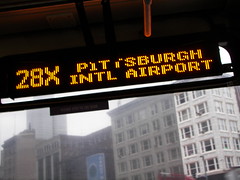
However, more people ride the bus to Seattle from the airport, even though the usage for the Pittsburgh bus is high, so comparatively it's easier to take luggage to/from the Pittsburgh airport compared to Seattle.
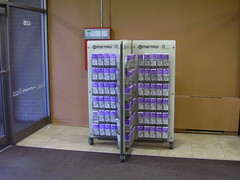
Transit Information Rack, University Book Store, University of Washington, Seattle
Still one thing that I don't think WMATA (or DC for that matter) does very well is use transit points of purchase (bus stops, subway stations) and frequently used places as points to promote and distribute information about transit.
I mention this because I didn't go to many places yesterday--the airport, Pike Place Market, and the University District adjacent to the University of Washington--but I found in each place a massive rack distributing information about public transit (which in this region includes ferry service). Plus, the buses had information displayed as well, including the Sound Transit published Transit Guide.
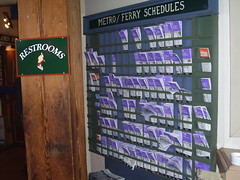
Rack of transit schedule information, Pike Place Market.
3. By way of comparison, at National Airport in Terminal A, there are two transit brochures, one the schedule for the 5A bus line to Dulles Airport and another general brochure (but no maps or other promotional materials displayed) in an information rack affixed to an information booth.. Granted there is the subway station, which is a promotion in and of itself, but I write frequently that we need to better utilize these stations as places to promote transit.
At the Seattle-Tacoma airport, a large information rack for public transit was immediately adjacent to the Visitor Information desk. I think information about transit was also placed in the various visitor information racks too. Plus the signage pointing people to the public transit ground transportation options was also pretty clear.
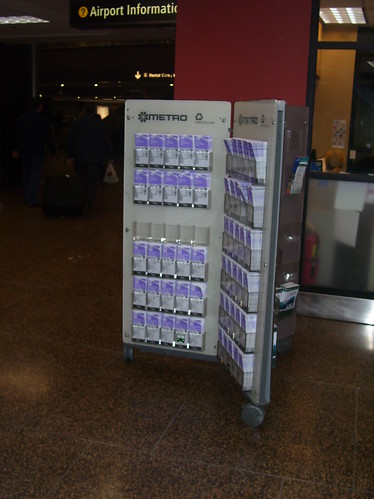
Plus, this poster, promoting transit as a viable way to get around, was affixed to one of the boards in the six-sided information rack.

And the signage at the bus stop explained how to use the system very well, and how to get to various places in the region from the airport, using public transit.
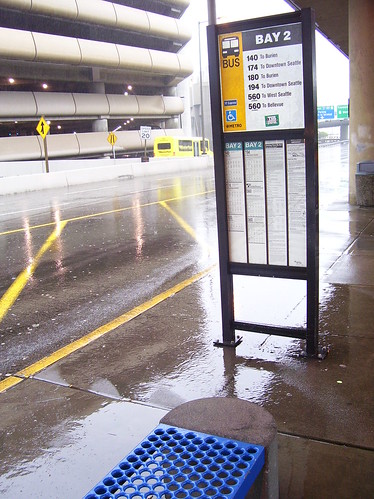
This reminds me of my first experience using the subway at National Airport about 20 years ago. I was new to the city and someone asked me how to get to Germantown by transit. I had no idea. And looking at the map of the subway system even today, how would you know you can get to Germantown by taking the red line to Shady Grove?
These transit-promotion materials were available in the various information racks I have come across so far in Seattle. (I know that some of these kinds of guides are made available by WMATA, or the county-based bus systems. But I don't think there are many such comprehensive guides for the DC region. And these kinds of materials are likely inadequately distributed in our region.)
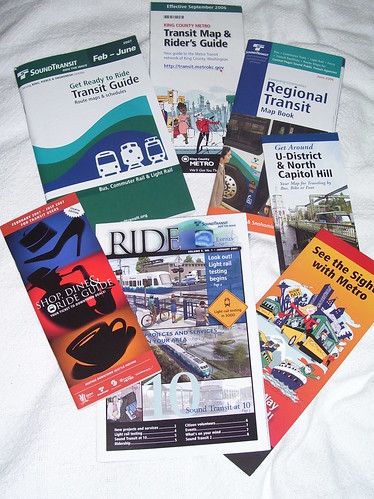
Labels: transit marketing

1 Comments:
Reposted from Rebuilding Place in the Urban Space (for the convenience of our readers):
I'm so excited to see you write about Seattle's transit... I paid close attention to it when I was there in November 2005 for a week. (I may visit there again over Memorial day weekend for 5 days.) The places you wrote about I actually have images of in my head.
Are they still working on the bus tunnel? They just closed it down when I was there. And do they still have the fareless square?
I have some great pictures on my phone of various aspects of Seattle transit... the Bellevue bus center, the neat pattern on the seats of the SoundTransit busses. If you'd like my Seattle and area transit pictures, let me know... I'll email them to you.
I also noticed the plethora of information that was available on busses, etc. in Seattle. I remember being bored on the trip to the Airport on the bus (you're right, they need luggage racks) and picking up one of the many informative booklets on the bus and reading it for fun. I like how many of the booklets encourage thinking about transit instead of being purely informative, like maps and schedules and farecharts. They have stuff like the "getting ready to ride" transit guide (I think that was the one I read on my way to SeaTac) and Getting Around So-and-So district and bikes on the system instead of just "Bus 52 Schedule" and "System Map". DC needs more of this style of information. As it is now, people aren't encouraged to think about transit, to figure out how to use it and to incorporate it into many facets of their daily life. They're told "here's the schedules". But they need to be taught how to think about transit, and, indeed, TO think about it.
Post a Comment
<< Home